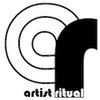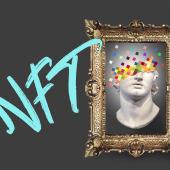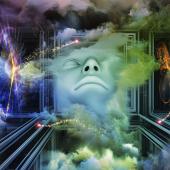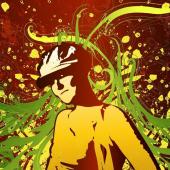Digital Art
Where once colour application and brushwork were of interest, today there are GIF files, encryption codes and ASCII. Since a long time, art has not only been developed analogously and with brush strokes. However, digital art also changes the self-perception and the representation of corpuses. About digital art and its possibilities:
When data becomes art
You remember a view through the kaleidoscope: the ornament-like structures sometimes look geometric, sometimes floral and never stand still. Here, an electrically generated hum of a didgeridoos sounds. Nevertheless, what the viewer sees are transformed hormone levels of newborns. Data are beeing transformed into animated graphics by the help of algorithmic methods. It was the idea of the artist Huang Siying: "Everyone has a different hormonal level at birth. The data I work with comes from an Internet database. Using the algorithm, I can generate an infinite number of forms. In addition, you can hear this archaic sound of didgeridoos. I would like to try to bring together the pain and the vitality of the birth process in my art”, so the artist in a German radio interview.
However, this is just one example that illustrates the possibilities of digital form language. As the father of digital art, one acclaims the American artist Laurence Gartel. As early as the end of the 1970s, he photographed a video, edited it and shooted the result again as a photo. Digital art was born.
Famous are the Pamela Anderson works by the New York painter Mark Napier. A Venus 2.0. He created a Venus 2.0 with Internet pictures of her. This was made possible by a software developed by him, with which the individual body parts of the sex icon were compiled based on Internet pictures.
The NRW-Forum Düsseldorf also presented an exhibition on the topic virtual body last year. It is certain that our personal perception and the presentation of the bodies has become a different one thanks to digital form language and its various possibilities. It remains exciting where digital art will lead us.
Praxisnahe Tipps & Tricks sowie Beratung zu dem Thema Digitale Kunst
Q: Was ist digitale Kunst und wie unterscheidet sie sich von traditioneller Kunst?
A: Digitale Kunst, auch bekannt als Digitalkunst oder Computerkunst, umfasst Kunstwerke, die mit digitalen Technologien geschaffen oder bearbeitet wurden. Sie unterscheidet sich von traditioneller Kunst dadurch, dass sie in digital kodierter und gespeicherter Form existiert und oft digitale Geräte für ihre Erstellung und Präsentation nutzt. Während traditionelle Kunstformen wie Malerei und Skulptur mit physischen Materialien und Techniken arbeiten, verwendet digitale Kunst Software und digitale Geräte zum Kunst schaffen. Digitale Kunst kann eine Vielzahl von Formen annehmen, darunter digitale Malerei, Fotomanipulation, 3D-Modellierung, Animation, Videokunst, digitale Collagen und vieles mehr. Künstler können mit verschiedenen digitalen Werkzeugen und Programmen arbeiten, um ihre kreativen Visionen zum Ausdruck zu bringen und innovative Kunstwerke zu schaffen.
Digitale Kunst ermöglicht es Künstlern, auf einfache Weise Farben zu mischen, Formen zu verändern, Effekte hinzuzufügen und leicht zu experimentieren, ohne physische Materialien zu verschwenden. Außerdem bietet die digitale Kunst die Möglichkeit, Kunstwerke einfach zu reproduzieren und zu verbreiten, da sie in digitaler Form vorliegen.
Die digitale Kunst hat die Kunstwelt revolutioniert und neue Möglichkeiten für Künstler geschaffen. Sie ermöglicht es Künstlern, traditionelle Techniken mit modernen digitalen Werkzeugen zu kombinieren und ein breiteres Publikum zu erreichen. Digitale Kunstwerke können online geteilt und verbreitet werden, was es Künstlern ermöglicht, global bekannt zu werden.
Insgesamt hat die digitale Kunst die kreative Landschaft erweitert und neue Horizonte für Künstler eröffnet. Sie hat die Kunst demokratisiert und es Menschen ermöglicht, ihre kreative Seite auf innovative Weise auszudrücken. Die digitale Kunst wird weiterhin wachsen und sich entwickeln, da neue Technologien und Programme ständig auf den Markt kommen und Künstlern neue Möglichkeiten bieten, ihre Kunst zu schaffen.
Q: Welche Technologien werden typischerweise genutzt, um digitale Kunstwerke zu erstellen?
A: Zur Erstellung von digitalen Kunstwerken werden diverse Technologien genutzt, darunter Grafiktabletts, digitale Zeichenprogramme, 3D-Modellierungssoftware und Programme für computergenerierte oder generativen Kunst. Diese Werkzeuge erlauben Künstlern, digitale Bilder und Objekte zu kreieren, die ohne die Einbindung digitaler Technologien nicht möglich wären. Ein Grafiktablett ist ein Eingabegerät, das es Künstlern ermöglicht, direkt auf einer digitalen Oberfläche zu zeichnen und zu malen. Durch den Einsatz von Stiften oder Pens können sie präzise Linien und Farben auf dem Bildschirm erstellen.
Digitale Zeichenprogramme bieten eine Vielzahl von Werkzeugen und Funktionen, um digitale Kunstwerke zu erstellen. Künstler können hiermit verschiedene Techniken wie Malen, Zeichnen und Fotomanipulation anwenden.
3D-Modellierungssoftware ermöglicht es Künstlern, dreidimensionale Objekte und Szenarien zu erstellen. Durch die Manipulation von Formen, Texturen und Farben können sie realistische oder abstrakte 3D-Kunstwerke kreieren.
Programme für computergenerierte oder generative Kunst nutzen Algorithmen und mathematische Modelle, um automatisch Kunstwerke zu erstellen. Diese Art von Technologie erlaubt es Künstlern, kreative Prozesse zu automatisieren und einzigartige Kunstwerke zu generieren.
Insgesamt ermöglichen digitale Technologien Künstlern eine Vielzahl von Möglichkeiten, um ihre kreativen Ideen umzusetzen und neue Formen der Kunst zu erforschen. Durch die Verbindung von traditionellen künstlerischen Techniken mit innovativen digitalen Werkzeugen entstehen einzigartige und faszinierende Kunstwerke.
Q: Ist digitale Kunst eine anerkannte Form zeitgenössischer Kunst?
A: Ja, digitale Kunst ist eine weit anerkannte und praktizierte Kunstform innerhalb der zeitgenössischen Kunstszene. Viele zeitgenössische Kunstausstellungen und -galerien präsentieren digitale Kunstwerke, und die Kunstform wird von einer wachsenden Zahl von Künstlern, Kuratoren und Kunstliebhabern angenommen und gefördert. Die Welt der digitalen Kunst ist zunehmend prägend für den Diskurs der bildenden Kunst. Digitale Kunst wird oft als eine Form der zeitgenössischen Kunst angesehen, die sich mit digitalem Medium und Technologie befasst. Künstler verwenden Programme und Software, um digitale Kunstwerke zu erstellen, die eine Vielzahl von Formaten und Stilen umfassen können, darunter digitale Gemälde, Animationen, Videos, interaktive Installationen und virtuelle Realität.
Die Technologien, die für die Erstellung digitaler Kunstwerke verwendet werden, entwickeln sich ständig weiter, was Künstlern die Möglichkeit gibt, immer innovative und experimentelle Werke zu schaffen. Digitale Kunst ermöglicht es Künstlern, neue Wege zu erkunden, um ihre Ideen und Visionen zu verwirklichen, und ermöglicht es ihnen, mit verschiedenen Techniken und Materialien auf virtueller Ebene zu experimentieren.
Digitale Kunst hat auch neue Formen der Kunstproduktion und -verbreitung ermöglicht, insbesondere durch die Verwendung von Online-Plattformen und sozialen Medien. Künstler können digitale Kunstwerke online präsentieren, verkaufen und teilen, was ihnen eine größere Reichweite und Sichtbarkeit verschafft.
Insgesamt hat die digitale Kunst eine bedeutende Rolle in der zeitgenössischen Kunstszene eingenommen und trägt dazu bei, den Dialog über die Verbindung von Kunst und Technologie voranzutreiben. Sie hat sich zu einer vielfältigen und dynamischen Kunstform entwickelt, die sowohl etablierte als auch aufstrebende Künstler inspiriert und begeistert.
Q: Wie können digitale Kunstwerke einem Publikum zugänglich gemacht werden?
A: Digitale Kunstwerke können auf vielfältige Weise einem Publikum zugänglich gemacht werden, einschließlich Online-Galerien, digitalen Ausstellungen, Projektionen, interaktiven Installationen und virtuellen Realitätserfahrungen. Die digitale Natur ermöglicht es, die Kunst in einem breiteren Rahmen zu teilen und zu erleben, oft über das Internet. Zudem ermöglichen soziale Medien und digitale Plattformen, digitale Kunst einem globalen Publikum vorzustellen. Digitale Kunstwerke können auch auf physische Medien gedruckt werden, wie Leinwände, Poster oder Kunstdrucke, um sie in traditionellen Galerien oder Ausstellungsräumen zu präsentieren. Zusätzlich können digitale Kunstwerke als Hintergrundbilder für Computer, Smartphone oder Tablet verwendet werden, um sie in den Alltag der Betrachter zu integrieren.
Ein weiterer Weg, digitale Kunstwerke einem breiteren Publikum zugänglich zu machen, sind digitale Kunstmärkte und Plattformen, auf denen Künstler ihre Werke zum Verkauf anbieten können. Diese Plattformen ermöglichen es Kunstliebhabern, digitale Kunstwerke zu entdecken, zu kaufen und zu sammeln und bieten Künstlern die Möglichkeit, ihre Werke einem internationalen Markt zu präsentieren.
Insgesamt bieten digitale Kunstwerke viele Möglichkeiten, sie einem Publikum zu präsentieren und zu teilen, und ermöglichen es Künstlern, ihre Kreativität auf vielfältige Weise auszudrücken. Mit der ständigen Weiterentwicklung der digitalen Technologien wird die Verbreitung und Erfahrung von digitaler Kunst sicherlich weiter wachsen und sich verändern.
Q: Welche Rolle spielt die Technologie in der Entwicklung von digitaler Kunst?
A: Technologie spielt eine zentrale Rolle in der Entwicklung von digitaler Kunst. Die kontinuierliche Weiterentwicklung digitaler Werkzeuge und Medien eröffnet Künstlern neue Möglichkeiten, ihre kreativen Visionen auszudrücken. Neue Software, verbesserte Hardware und innovative digitale Plattformen treiben die Evolution der digitalen Kunst stetig voran, indem sie die Grenzen dessen, was möglich ist, erweitern und die Art und Weise, wie Kunst geschaffen und präsentiert wird, neu definieren. Die dynamische Entwicklung der Technologie hat in der Tat einen tiefgreifenden Einfluss auf die Kunstwelt und insbesondere auf die digitale Kunst. Durch die kontinuierliche Innovation in der Software- und Hardwareentwicklung werden Künstlerinnen und Künstlern Tools an die Hand gegeben, die nicht nur die Effizienz und Präzision ihrer Arbeit verbessern, sondern ihnen auch ermöglichen, ganz neue kreative Pfade zu beschreiten.
Eines der deutlichsten Beispiele dieser Evolution ist die Einführung und ständige Verbesserung von Grafiktablets und digitalen Zeichenprogrammen, die ein präzises Zeichnen und Malen direkt auf dem Bildschirm ermöglichen. Diese Werkzeuge haben es Digital Artists ermöglicht, ihre künstlerischen Fähigkeiten auf eine Weise zu erweitern, die mit traditionellen Medien nicht möglich wäre. Außerdem erleichtern voreingestellte Pinsel, eine unendlich erscheinende Farbauswahl und die Möglichkeit, Fehler rückgängig zu machen, den kreativen Prozess enorm.
Weiterhin ermöglichen es 3D-Modellierungssoftware und -Techniken Künstlern, atemberaubende dreidimensionale Kunstwerke und Animationen zu schaffen, die realistische oder fantasievolle Welten zum Leben erwecken. Die Weiterentwicklung dieser Technologien bietet einen immensen Detailgrad und eine Komplexität, die bisher unerreichbar war.
Virtual Reality (VR) und Augmented Reality (AR) haben ebenfalls neue Möglichkeiten für die digitale Kunst geschaffen, indem sie interaktive Erlebnisse bieten, die den Betrachter in eine vollständig immersiven Umgebung eintauchen lassen. Diese Technologien verwischen die Grenzen zwischen der realen Welt und der digitalen Kunst, indem sie die Betrachter in die Lage versetzen, Kunstwerke auf eine Weise zu erleben, die zuvor unmöglich war.
Nicht zu vergessen sind digitale Plattformen und soziale Medien, die es Künstlern ermöglichen, ihre Werke einem globalen Publikum vorzustellen. Diese Plattformen bieten nicht nur eine enorme Reichweite, sondern auch die Möglichkeit, sich mit anderen Künstlern zu vernetzen, zusammenzuarbeiten und von einander zu lernen.
Die zukünftige Entwicklung der Technologie wird zweifellos weitere revolutionäre Werkzeuge und Plattformen für digitale Künstler mit sich bringen, wodurch die Grenzen der kreativen Expression immer weiter ausgedehnt werden.
Q: Können computergenerierte Kunstwerke als echte Kunst angesehen werden?
A: Computergenerierte Kunstwerke werden von vielen in der Kunstwelt als echte Kunstform anerkannt. Sie erfordern ein tiefes Verständnis künstlerischer Prinzipien sowie Kenntnisse in Programmierung und digitaler Technologie. Da sich die Kunst immer mit den verfügbaren Mitteln ihrer Zeit entwickelt hat, ist die Integration von Technologie in den kreativen Prozess ein natürlicher Schritt in der Evolution der Kunst. Computergenerierte Kunst stellt häufig die Beziehung zwischen Technologie, Künstler und Betrachter in Frage und erzeugt in diesem Zusammenhang bedeutungsvolle Diskussionen und Reflexionen. Durch die Verwendung von Algorithmen und Computern können Künstler komplexe und abstrakte Werke schaffen, die mit traditionellen Methoden nur schwer oder gar nicht realisierbar wären. Die Möglichkeiten der Digitaltechnologie eröffnen neue Wege der kreativen Selbstexpression und erlauben es Künstlern, ihre Fantasie und Vorstellungskraft auf beeindruckende Weise zum Ausdruck zu bringen.
Ein weiterer Aspekt der computergenerierten Kunst ist die Frage nach der Autorschaft und Originalität. Da viele Werke durch Algorithmen und Programme erstellt werden, stellt sich die Frage, ob der Künstler weiterhin als Schöpfer des Kunstwerks angesehen werden kann. Diese Diskussionen über die Rolle des Künstlers in der digitalen Welt tragen zur Entwicklung und Definition der Kunstform bei.
Insgesamt lässt sich sagen, dass computergenerierte Kunst eine faszinierende und vielschichtige Kunstform ist, die sich stetig weiterentwickelt und neue ästhetische und kreative Möglichkeiten eröffnet. Sie ermöglicht es Künstlern, innovative und einzigartige Werke zu schaffen, die das Verhältnis zwischen Mensch, Technologie und Kunst auf spannende Weise erkunden.
Q: Welche Herausforderungen bestehen beim Kauf und der Sammlung von digitalen Kunstwerken?
A: Beim Kauf und der Sammlung von digitalen Kunstwerken bestehen einige Herausforderungen, insbesondere im Hinblick auf Echtheitszertifikate, Urheberrechte und die Langzeitarchivierung. Digitale Kunstwerke sind oft leicht kopierbar, was Fragen bezüglich der Originalität und Eigentumsrechte aufwirft. Lösungen wie die Blockchain-Technologie und Non-Fungible Tokens (NFTs) bieten neue Wege, um Eigentums- und Urheberrechte digital zu verifizieren. Die dauerhafte Speicherung und Erhaltung digitaler Kunst erfordert ebenfalls besondere Überlegungen, da Technologien veralten und digitale Formate sich ändern können. Es ist wichtig für Sammler von digitaler Kunst, sich über diese Herausforderungen bewusst zu sein und geeignete Maßnahmen zu ergreifen, um ihre Sammlung zu schützen und zu erhalten. Dazu gehören die Verwendung von vertrauenswürdigen Plattformen für den Kauf und Verkauf von digitalen Kunstwerken, die Sicherung von Echtheitszertifikaten und Urheberrechten, sowie die regelmäßige Aktualisierung und Migration von digitalen Dateien, um sicherzustellen, dass sie auch in Zukunft zugänglich sind.
Darüber hinaus sollten Sammler von digitaler Kunst auch darauf achten, wie sie ihre Sammlung präsentieren und teilen. Digitale Kunstwerke können auf verschiedenen Plattformen und Geräten unterschiedlich aussehen, daher ist es wichtig, sicherzustellen, dass sie in der gewünschten Form präsentiert werden. Die Verwendung von sicheren Speicherlösungen und regelmäßigen Backups kann ebenfalls dazu beitragen, die langfristige Erhaltung der digitalen Kunst zu gewährleisten.
Insgesamt bieten digitale Kunstwerke eine spannende Möglichkeit für Sammler, neue Formen von Kunst zu entdecken und zu unterstützen. Indem man sich mit den Herausforderungen der digitalen Kunst auseinandersetzt und entsprechende Schutzmaßnahmen ergreift, kann man seine Sammlung langfristig genießen und schützen.
Q: Wie wirkt sich digitale Kunst auf die Wahrnehmung traditioneller Kunstformen aus?
A: Digitale Kunst beeinflusst und bereichert die Wahrnehmung traditioneller Kunstformen, indem sie neue Perspektiven und Interpretationsmöglichkeiten einbringt. Die Integration digitaler Elemente in die bildende Kunst hat zu hybriden Formen geführt, die die Grenzen zwischen traditioneller und digitaler Kunst verwischen. Sie regt Diskussionen über den Wert und die Bedeutung von Kunst in der digitalen Ära an und fördert einen interdisziplinären Austausch zwischen unterschiedlichen Kunstbereichen. Die Präsenz digitaler Kunst inspiriert sowohl traditionelle Künstler als auch das Publikum, die Rolle und den Einfluss von Technologie auf die Kunst neu zu bewerten.
Digitale Kunst bietet Künstlern die Möglichkeit, mit neuen Medien und Technologien zu experimentieren und ihre kreativen Grenzen zu erweitern. Durch die Verwendung von Software, Virtual Reality, 3D-Druck oder interaktiven Medien können Künstler einzigartige Werke schaffen, die traditionelle Materialien und Techniken überschreiten.
Die Vermischung von digitalen Elementen mit traditioneller Kunst eröffnet neue Möglichkeiten für die Betrachtung und Interpretation von Kunstwerken. Durch die Integration von Bewegung, Sound, Interaktivität oder virtuellen Realitäten können Künstler die Sinne des Betrachters ansprechen und neue Erlebnisse schaffen.
Darüber hinaus ermöglicht digitale Kunst eine breitere Zugänglichkeit und Verbreitung von Kunstwerken. Mit Hilfe von Online-Plattformen, sozialen Medien und digitalen Ausstellungen können Künstler ihre Werke einem globalen Publikum präsentieren und mit anderen Kunstschaffenden vernetzen.
Insgesamt bereichert die Digitalisierung die Kunstwelt und eröffnet neue Perspektiven für Künstler, Betrachter und Kunstinstitute. Es bleibt spannend zu beobachten, wie sich die Beziehung zwischen traditioneller und digitaler Kunst weiterentwickelt und welche innovativen Werke in Zukunft entstehen werden.
Experten-Tipps & Erfahrungen zu dem Thema Digitale Kunst
Entdecken Sie die Welt der Digitalen Kunst: Eine Reise durch digitale Kunstformen und Kunstwerke
Willkommen in der faszinierenden Welt der digitalen Kunst, einem dynamischen Feld, in dem Technologie und Kreativität verschmelzen, um etwas völlig Neuartiges zu erschaffen. In der digitalen Ära, in der wir leben, hat sich die digitale Kunst als ein vielseitiger und ausdrucksstarker Kunstzweig etabliert, der die traditionellen Grenzen der Kunst erweitert und neu definiert. Tauchen Sie mit uns ein in die vielschichtige Welt der digitalen Kunst, von ihrer Entstehungsgeschichte über die Schaffung digitaler Meisterwerke bis hin zur Bedeutung digitaler Kunst in der heutigen Zeit.
Was ist digitale Kunst und wie unterscheidet sie sich von traditioneller Kunst?
Die Grundlagen der digitalen Kunst: Definition und Ursprünge
Digitale Kunst, oft auch als Computerkunst oder computergenerierte Kunst bezeichnet, besteht aus Kunstwerken, die mithilfe digitaler Technologien geschaffen oder verarbeitet werden. Diese Form der Kunst umfasst eine breite Palette von Medien, darunter digitale Bilder, Animation, Videokunst und sogar digitale Skulpturen. Die Wurzeln der digitalen Kunst reichen zurück bis in die 1960er Jahre, als Künstler begannen, Computer als Werkzeug für die Erstellung von Kunst zu experimentieren. Seither hat sich das Feld ständig weiterentwickelt, wobei neue Technologien wie künstliche Intelligenz und virtuelle Realität neue Formen und Ausdrucksmöglichkeiten eröffnen.
Digitale vs. traditionelle Kunstformen: Ein Vergleich
Im Gegensatz zu traditioneller Kunst, die physische Materialien wie Farbe und Leinwand verwendet, entsteht digitale Kunst in einem virtuellen Umfeld. Künstler nutzen dabei fortschrittliche Software und Geräte wie Grafiktabletts, um ihre Visionen zu realisieren. Während traditionelle Kunstformen wie Malerei und Bildhauerei durch die Materialbeschränkungen definiert sind, bietet die digitale Kunst eine nahezu unbegrenzte Flexibilität in Bezug auf Gestaltung und Ausführung. Dies erlaubt Künstlern, auf unkonventionelle Weise zu experimentieren und Kunstwerke zu schaffen, die in der physischen Welt nicht möglich wären.
Wie digitale Technologie die Kunst revolutioniert hat
Die Einführung digitaler Technologien in den künstlerischen Schaffensprozess hat eine Revolution in der Welt der Kunst ausgelöst. Digitale Kunstwerke können leicht vervielfältigt und weltweit über das Internet verbreitet werden, wodurch sie einem breiteren Publikum zugänglich gemacht werden. Zudem ermöglichen Technologien wie generative Kunst und Algorithmen Künstlern, Werke zu erzeugen, die sich in Echtzeit verändern oder auf das Verhalten des Betrachters reagieren. Digitale Kunst wirft auch Fragen hinsichtlich Authentizität und Urheberteile auf und führt zu neuen Formen wie NFT-Kunst, die das Eigentum an digitalen Kunstwerken mittels Blockchain-Technologie verifiziert.
Wie werden digitale Kunstwerke geschaffen?
Die Rolle der Technologie im künstlerischen Schaffensprozess
Im Herzen der digitalen Kunst steht die enge Verbindung zwischen dem Künstler und der Technologie. Computer und spezialisierte Software bieten Werkzeuge, die Details mit einer Präzision ermöglichen, die weit über das hinausgeht, was mit traditionellen Methoden möglich ist. Von der digitalen Malerei und Bildbearbeitung bis hin zu komplexen 3D-Modellierungen und Animationen, die Technologie fungiert als Erweiterung des künstlerischen Ausdrucks. Sie ermöglicht es, Visionen ohne die physische Einschränkungen traditioneller Medien umzusetzen.
Werkzeuge und Software, die Künstler für die Erstellung von digitalem Art nutzen
Zu den wichtigsten Werkzeugen in der Welt der digitalen Kunst gehören leistungsfähige Grafiksoftware wie Adobe Photoshop, Illustrator sowie 3D-Modellierungsprogramme wie Blender und Autodesk Maya. Diese Programme bieten Künstlern eine breite Palette an Funktionen, von einfacher Bildbearbeitung bis hin zur Erstellung komplexer, computergenerierter Welten. Grafiktabletts und digitale Stifte ermöglichen eine intuitivere und natürlichere Interaktion mit dem digitalen Medium, wodurch die Kluft zwischen traditioneller und digitaler Kunst weiter verringert wird.
Der Prozess von der Idee bis zum fertigen digitalen Kunstwerk
Der kreative Prozess in der digitalen Kunst beginnt oft mit einer Idee oder Konzeption, die dann digital umgesetzt wird. Dies kann eine reine Computerkreation sein oder eine digitale Überarbeitung traditioneller Kunst. Künstler nutzen oft Skizzierprogramme, um Entwürfe zu erstellen, bevor sie zum eigentlichen Schaffensprozess übergehen, der das endgültige Kunstwerk in digital kodierter und gespeicherter Form hervorbringt. Dieser Prozess umfasst oft zahlreiche Schritte, von der Modellierung und Texturierung in 3D-Anwendungen bis hin zur finalen Postproduktion, um das gewünschte visuelle Ergebnis zu erreichen.
Die bedeutendsten digitalen Künstler und ihre Werke
Pioniere der Digital Art und ihr Einfluss auf zeitgenössische Kunstformen
Zu den Pionieren der digitalen Kunst zählen Künstler wie Herbert W. Franke und Harold Cohen, die schon früh das Potenzial der Computer für die Kunst erkannten und erforschten. Ihre Arbeiten und Experimente legten den Grundstein für die Entwicklung der digitalen Kunst als eine eigene Kunstform, die sich stetig weiterentwickelt und neue Möglichkeiten in der Ausdrucksfähigkeit bietet. Diese frühen digitalen Künstler öffneten die Tür für nachfolgende Generationen, die digitale Technologie als integralen Bestandteil des künstlerischen Ausdrucks ansehen.
Ausgewählte digitale Kunstwerke und ihre Bedeutung
Von beeindruckenden 3D-Landschaften bis hin zu hyperrealistischen Porträts reichen die Schöpfungen digitaler Künstler. Ein herausragendes Beispiel für die Möglichkeiten digitaler Kunst ist das Werk "The Treachery of Sanctuary" von Chris Milk. Diese interaktive Installation nutzt computergenerierte Bilder und Bewegungserfassung, um die Schatten der Teilnehmer in flügelartige Formen zu verwandeln, wodurch eine fesselnde Erfahrung geschaffen wird, die die Grenzen zwischen Kunstwerk und Betrachter verwischt.
Wie digitale Künstler die Grenzen der Kunst erweitern
Durch den Einsatz digitaler Technologien pushen digitale Künstler konstant die Grenzen dessen, was als Kunst angesehen wird. Sie experimentieren mit neuen Mediumsformen wie Virtual Reality und generativer Kunst, die das Publikum nicht nur als passive Betrachter, sondern als aktive Teilnehmer einbindet. Diese Innovationen erweitern die Definition von Kunst und schaffen völlig neue Erfahrungen und Ausdrucksformen, die die Vorstellungskraft anregen und zum Nachdenken anregen.
Wie kann man selbst mit dem Schaffen von digitaler Kunst beginnen?
Erste Schritte in der Welt der digitalen Kunst für Anfänger
Der Einstieg in die digitale Kunst kann zunächst herausfordernd erscheinen, doch mit dem richtigen Ansatz und den passenden Ressourcen ist es für jeden möglich, seine künstlerischen Fähigkeiten in diesem Medium zu entwickeln. Ein guter Startpunkt ist die Auseinandersetzung mit den Grundprinzipien des Designs sowie das Experimentieren mit verschiedenen Softwareprogrammen und Werkzeugen, um ein Gefühl für das Medium zu bekommen. Online-Kurse und Tutorials bieten eine hervorragende Möglichkeit, sich mit den technischen Aspekten der digitalen Kunst vertraut zu machen und die eigenen Fähigkeiten schrittweise zu verbessern.
Wichtige Ressourcen und Tools für angehende digitale Künstler
Für angehende digitale Künstler sind Zugang zu Bildungsressourcen und die richtigen Werkzeuge entscheidend. Kostenlose und kostenpflichtige Software wie GIMP, Adobe Photoshop und Illustrator sowie 3D-Software wie Blender bieten vielfältige Möglichkeiten, kreativ zu werden. Online-Plattformen wie Udemy, Coursera und YouTube hosten zahlreiche Tutorials und Kurse, die sich auf digitale Kunst und ihre verschiedenen Aspekte konzentrieren. Zusätzlich können soziale Medien und Online-Communities wie Instagram und DeviantArt für Inspiration, Feedback und Unterstützung genutzt werden.
Tipps und Tricks: Wie Sie Ihre Fähigkeiten in der digitalen Kunst verbessern können
Um Ihre Fähigkeiten in der digitalen Kunst zu verbessern, ist es wichtig, regelmäßig zu üben und offen für neues Lernen zu sein. Experimentieren Sie mit verschiedenen Stilen und Techniken, um Ihren eigenen künstlerischen Ausdruck zu finden. Feedback von anderen Künstlern und der Community kann wertvolle Einblicke bieten, die Ihnen helfen, Ihre Arbeit weiterzuentwickeln. Verfolgen Sie außerdem aktuelle Trends und Technologien in der digitalen Kunst, um inspiriert zu bleiben und Ihre Kenntnisse auf dem neuesten Stand zu halten. Das Wichtigste ist, kreativ zu bleiben, zu experimentieren und den Prozess des Schaffens zu genießen.




